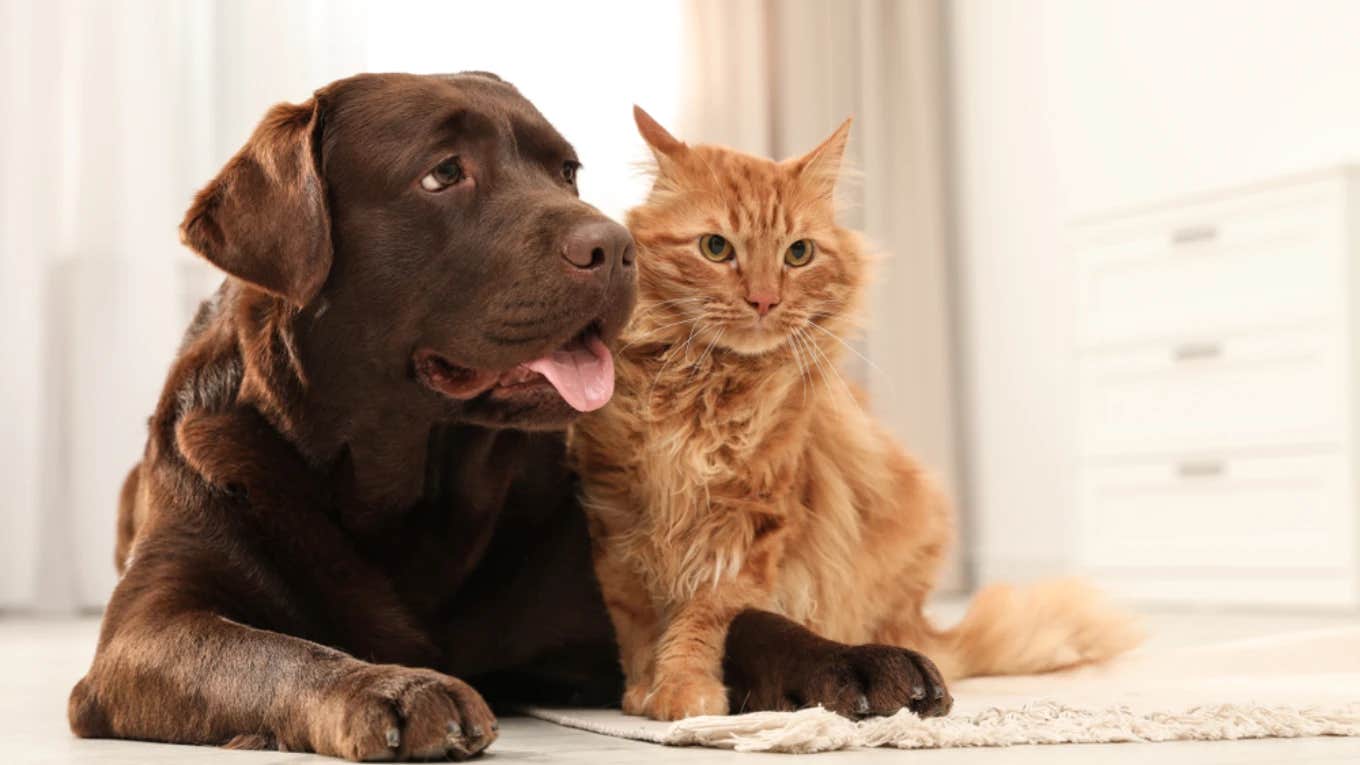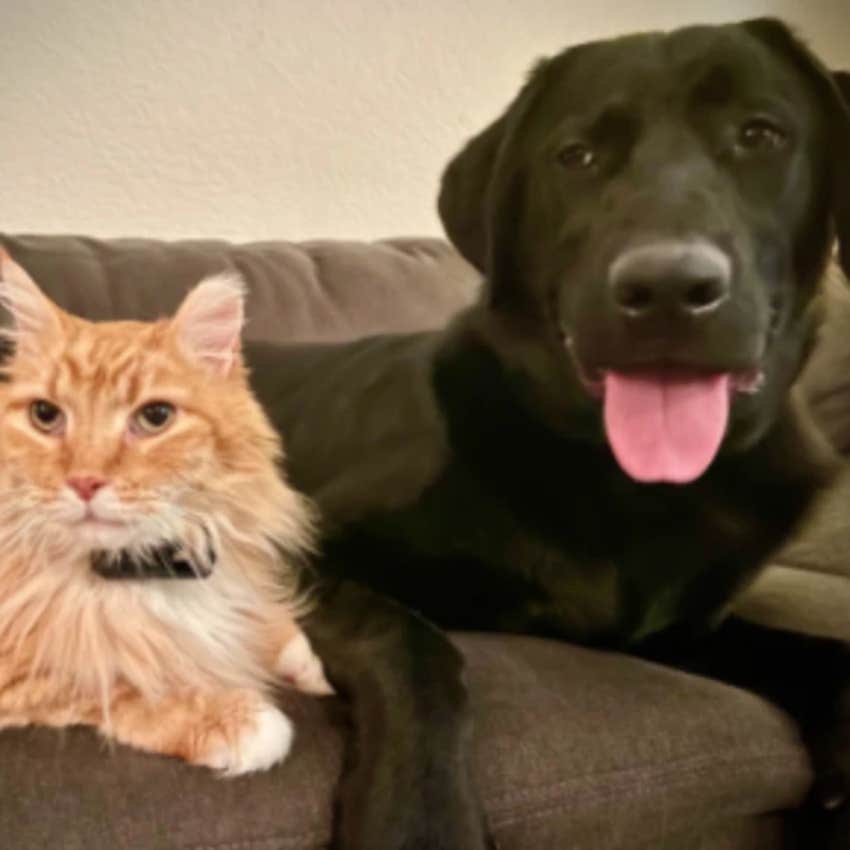How Two Pets Went From Enemies To Best Friends With Help From An Animal Communicator
When introducing new pets, an animal communicator can help smooth the transition and strengthen bonds.
 New Africa / Shutterstock
New Africa / Shutterstock Adopting a pet and welcoming them into your home can be a fulfilling and exciting experience. However, it can also be a nerve-wracking one filled with uncertainties if you already have another pet living in your home.
Introducing your pets to each other doesn’t always go the way we imagine it will, and sometimes, they may end up hating each other. Thankfully, there are animal specialists who are more than willing to help families who encounter this dilemma and work to improve pets’ relationships with one another.
One family enlisted the help of animal communicator Ellie Laks after their cat was having difficulties getting along with their newly adopted dog.
Animal communicator Ellie Laks repaired the relationship between Medi the cat and Monkey the dog.
Laks, an animal behavioralist and communicator who has been rescuing, rehabilitating, and communicating with animals since she was a child, was recently contacted by pet owner Katie Otto for a consultation.
According to Otto, she had recently adopted Monkey, a large lab hound mix. After bringing Monkey home and introducing him to the rest of the family, their cat, Medi, made it abundantly clear that he was unhappy with the dog’s presence.
“Medi refused to come inside at night if he saw or heard Monkey,” Otto told YourTango. Medi, formerly a feral cat, often spends the night inside with the Ottos. However, after Monkey’s arrival, he decided that he would rather stay outdoors.
“At one point, we did try to keep him indoors (hoping he would get used to Monkey) and he promptly peed all over our bed!” Otto added.
Medi was also demonstrating signs of stress, refusing to eat, not sleeping normally, and losing weight.
Previously, Medi had only interacted with one other dog who was much smaller than Monkey, and typically had no interest in interacting with any other animals. “When other people visit our home or bring other animals to visit, Medi disappears outside until they leave,” Otto shared.
Monkey, on the other hand, was more than eager to get to know his new brother. “Monkey really wanted to play and make friends with Medi,” Otto said. “We did a very slow introduction, but Monkey was just too big and loud for Medi from the beginning.”
During their initial meeting, Medi “swatted” and “hissed” at Monkey, and spent most of his time outside when the dog was in the house. When Monkey was outside, Medi would retreat underneath the house.
 Photo: Katie Otto
Photo: Katie Otto
Devastated over the prospect of possibly having to rehome her newly adopted dog due to Medi’s behavior, she reached out to Laks for help, hoping that she could bridge the gap between the two.
Laks met with both Monkey and Medi individually, holding communication sessions with them to get to the root of their issues.
Animal communication is the use of intuition to speak with an animal, ask them questions, and learn significant information about them.
While communicating with a specific animal, Laks will look at a photo of them looking directly into the camera. After a few moments, she will look into the animal’s eyes and ask permission to speak with them. The process is similar to meditation, where she completely immerses herself into a mentally neutral space so that she can focus completely on an animal.
While communicating with Medi, Laks learned why he was so bothered by Monkey’s presence. According to Otto, Medi expressed his anger and frustration with the intrusion of Monkey into his once-peaceful life, sharing that he would now prefer to live outdoors than inside with Monkey. Medi also conveyed his “reluctance” to forgive Otto for bringing this “disruptive thing” into his life.
After her session with Medi, Laks communicated with Monkey. She expressed Medi’s need for a quiet and peaceful environment, which was now difficult to maintain due to Monkey’s puppy energy and barking. She also consoled Monkey and offered him helpful advice on how he could change his behavior to achieve a relationship with his cat brother.
Otto revealed that Monkey “transformed” after his session with Laks. He began to sit quietly and remain still whenever Medi was near. Eventually, Medi cautiously approached Monkey, and their relationship blossomed from wary glances to nose touches!
Now, five months later, the two are the best of friends, even grooming each other and sharing kisses!
 Photo: Katie Otto
Photo: Katie Otto
Medi and Monkey’s rocky start is a situation that many pet owners can resonate with when they bring a new animal home. Unfortunately, if the problem persists, many families have to rehome their beloved pets. However, with assistance from animal communicators like Laks, more and more pets will be able to peacefully co-exist.
Ellie Laks shared some helpful advice with YourTango for pet owners integrating new pets into their homes.
According to Laks, patience is crucial and the relationships between your pets should never be rushed.
“Animals need time to adjust and to create friendships with each other. Just like human siblings, there is jealousy, awkwardness, likes and dislikes between animals,” she said. “Give them time, set them up for success, don't expect the relationship to be perfect right away, reassure both parties that you love them, and spend time with them both together, and with both of them separately so they all feel nurtured.”
“Make sure there are plenty of food and water bowls to eliminate anyone feeling pushed away and get extra toys to eliminate any fights or arguments," Laks advised. "Avoid putting out any chew bones or cookies that they can fight over.”
For owners to understand their pets’ needs better, Laks highly recommends seeking the help of an animal communicator. “There is nothing better than hearing straight from the animal how they are feeling, and what they are needing and wanting,” she said.
“I would also encourage people to put down their phones, close their computers, and spend focused, present time with their animals at least once a day to deepen and strengthen their bond," Laks continued. "When we take the time to bond with our pets, we know them and they are speaking with us the same way they speak to me during readings.”
“I also believe that animals understand everything so talk out loud to your animal, let them know what is happening and why. Speak about and visualize what you do want and stay away from focusing on the behavior that you don't want.”
Our pets are much more intuitive than we give them credit for. Helping them get used to other pets in the house and attempting to improve their relationships will not only be beneficial to them but to the home’s environment as well.
Megan Quinn is a writer at YourTango who covers entertainment and news, self, love, and relationships.
